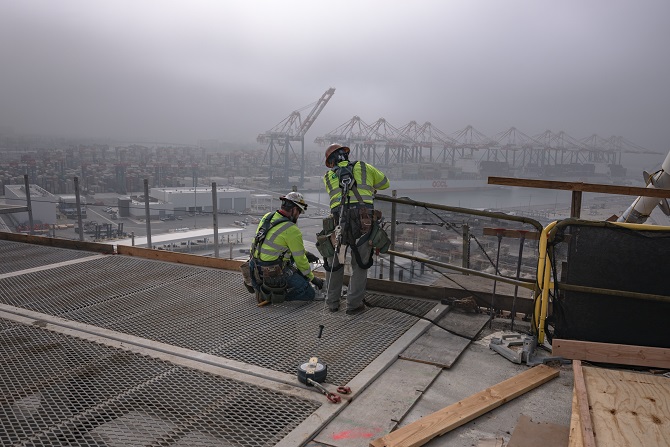
The end of bridge-building is finally in sight for Century City-based AECOM’s Shimmick Construction unit and the more than three dozen other contractors tasked with building the $1.5 billion replacement Gerald Desmond Bridge project at the Port of Long Beach.
After nearly six years of construction and months of delays due to wind and other factors, the construction team — led by the prime contractor trio of Shimmick, FCC Construction of Madrid and Salini Impregilo of Milan — has entered the final over-the-water phase of bridge construction, with an opening date set for next June for one of the most vital cargo transport routes in the nation.
In addition to the prime contractors, about three dozen subcontractors have worked on the project, including A & A Ready Mixed Concrete Inc. of Newport Beach.
But Shimmick and the other contractors have faced lots of delays that have pushed back the opening date by more than six months. High winds have prompted more frequent work stoppages than expected. And the contractors have had to proceed with caution because of the relative unfamiliarity with cable-stay construction.
“We are taking more time to make sure everything is done right and the segments are properly aligned,” said Duane Kenagy, capital programs executive for the Port of Long Beach and the port’s top point person for the bridge project. “This is the first cable-stayed vehicular bridge in California, so there has been a bit of a learning curve.”
The new span will replace the original Gerald Desmond Bridge, which was built in 1968 to link the port’s Terminal Island with downtown Long Beach and the 710 Freeway. It had become an increasingly vital thoroughfare for cargo traffic and the thousands of people working in and around the Long Beach and Los Angeles ports. As of last year, the bridge handled nearly 15% of the nation’s truck-transported imported cargo, according to the Port of Long Beach.
That bridge started to crumble in the early 2000s, with chunks of concrete falling off, making a new bridge essential.
At 1.5 miles, the replacement bridge now nearing completion is about a half-mile longer than the original. When complete, it will be the second-tallest cable-stayed bridge in the nation with its two towers reaching a height of 515 feet and a deck height of 205 feet.
The replacement bridge will have three general purpose lanes in each direction with the ability to handle roughly 75,000 vehicles per day; it will also have shoulder space to accommodate emergency and tow vehicles.
Over the last several weeks, work has been proceeding outward in both directions from each of the two towers that are anchored to the bedrock underneath the shipping channel, Kenagy said.
“This requires balanced cantilevered construction because the pressure has to be equally distributed” through the cable stays, he added.
According to Kenagy, there are now roughly 175 workers on the replacement bridge project, down from as many as 500 at the height of construction some 18 months ago.
Representatives from AECOM’s Shimmick unit declined to be interviewed, referring all questions on the bridge project to the Port of Long Beach.
But the company providing program direction for the project, Montreal-based WSP Global Inc., did discuss the construction process.
“Perhaps the most unique challenge was to construct this massive bridge without impacting the flow of cargo at one of the world’s busiest ports,” said Steve MacLennan, program director for the bridge project in WSP’s Long Beach office. “This required a lot of planning and working closely with the contractor, the Port of Long Beach and its tenants.”
Once the new bridge opens, one more task remains: tearing down the old bridge. That project is expected to cost about $67 million. The contract for the demolition is expected to be awarded late next year or early in 2021.
